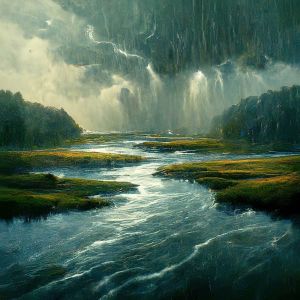Jala
| Jala | |
|---|---|
 | |
| Realm | Pelagia |
| Aspect | Rivers, lakes, and oceans |
| Osia | Jalasia |
Jala, the Primordial Spirit of Water, embodies fluidity, adaptability, and the power to nourish and transform. Born from the chaotic energies of Astram within the Primordial Void, Jala represents the ever-flowing force that nurtures life, reshapes the world, and binds together the cycles of renewal in Adaris. Where water flows, so too does the presence of Jala—beneath rivers, across oceans, and within the quiet mist of rain.
Nature and Influence
Jala encompasses all manifestations of water—from still pools to crashing tides. Its influence flows through ecosystems, emotions, and the unseen rhythms of life. As a spirit, Jala signifies not only the material force of water but also the metaphysical qualities of transformation, healing, and emotional depth.
Associated with cycles and transition, Jala represents impermanence and change. Water cleanses, reveals, obscures, and connects. In the emotional realm, Jala brings intuition, introspection, and spiritual purification. Its presence may soothe or overwhelm, but it always moves forward.
Realm
Jala’s domain, Pelagia, is a boundless oceanic realm where currents weave between lightless abysses and sunlit shallows. Unlike other spiritual realms defined by territory, Pelagia flows infinitely, shaped by the movement of tides and the breathing of the deep.
This realm is inhabited by water-spirits and fluid entities that defy fixed form. Waves carry memory, and creatures born of Pelagia often possess the ability to echo voices and emotions in currents. Portals between Pelagia and the material plane open where water gathers in strength—at river deltas, oceanic trenches, and sacred springs.
Osia
Jalasia is the branch of Osia tied to Jala, concerned with the shaping, channeling, and awakening of water spirits. Practitioners, known as Jalasiari, attune themselves to the subtle consciousness within every drop of water. They manipulate its motion and memory, using its fluid essence to heal, obscure, or reveal.
Jalasiari are often seen as mediators, healers, or guides, and their arts emphasize harmony with natural flows rather than domination. Advanced Jalasia allows practitioners to call forth rains, part rivers, or use moisture as a medium for resonance and vision. Water responds not to command, but to invitation.
Significance and Worship
Jala is honored wherever life depends on water. Shrines appear near springs, wells, and river confluences, often marked by flowing banners, driftwood carvings, or polished stones arranged in spiral patterns. Rituals typically involve immersion, reflection, and release.
Communities pray to Jala for rain, renewal, and protection from drought or flood. Ritual ablutions are central to many spiritual traditions, invoking Jala to cleanse both body and spirit. In coastal cultures, Jala is also viewed as a boundary keeper—between life and death, land and sea, certainty and change.
Cultural Practices
- The Offering Current – At the change of seasons, followers release leaf-wrapped offerings into rivers or lakes, believing Jala will carry their hopes and sorrows into the sea, where they will be transformed.
- The Tidewatch Vigil – Coastal communities gather at high tide under the full moon, meditating in silence as the waters rise and recede. It is a rite of patience, vision, and surrender to the natural rhythm of time.
- Vessels of Memory – Jalasiari craft glass or crystal vessels filled with layered water from sacred sources. These are said to hold emotional resonance and ancestral insight, used in rites of mourning, divination, or personal clarity.
- The Rainskin Rite – During drought, a ritual dance is performed under woven garments stitched with mirrored scales and beads. Each movement mimics the flow of rivers and calls to the distant waters of Pelagia.